We take a look at what’s in the pipeline (and the cables) for the WOHA-master-planned Punggol Digital District, where the digital economy is expected to grow and flourish.

The JTC Business Park will house key growth sectors from the cyber security and digital technology industries.
March 16th, 2018
Competitiveness, the digital economy, and urban design – it’s encouraging to see these three concepts being discussed in the same breath. Earlier this year, the Infocomm Media Development Authority (IMDA), JTC, Singapore Institute of Technology (SIT) and the Urban Redevelopment Authority (URA) unveiled the master plan for Punggol Digital District (PDD). The district is envisioned as a home for the growth industries of the digital economy, as well as a place for sustainable living and community inclusivity.
The PDD is part of Singapore’s strategy for using key development areas to bring ‘good jobs’ and social amenities closer to residents, and the URA refers to PDD as the first ‘Enterprise District’ integrating business and education, driven by technological, social and urban innovation.
“Our plan is to capitalise on future trends and the key assets in each area to develop highly integrated and inclusive spaces to live, work, play and learn,” says the URA’s CEO Lim Eng Hwee.
Says JTC’s Chief Executive Officer Ng Lang, “To be developed progressively, Punggol Digital District will be the first district to adopt a one integrated master plan approach that brings together a business park, a university and community facilities. Such a district-level planning approach creates synergies, optimises land use and catalyses community building. It also allows us to design and integrate technological and innovative platforms and services right from the start and from the ground up, potentially transforming the way we work, live, learn and play in an inclusive and sustainable district.”
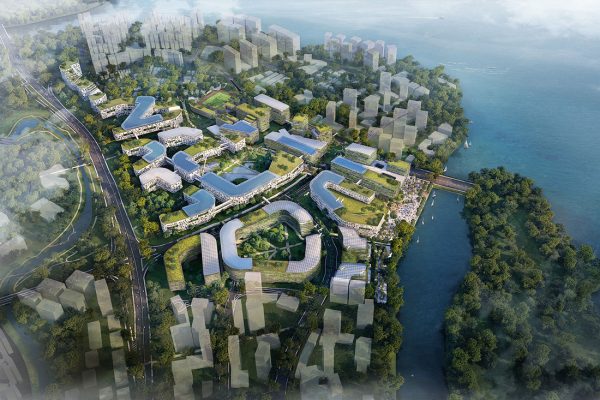
An aerial view of the proposed 50-hectare Punggol Digital District.
The SIT and JTC engaged WOHA to design the master plan. The firm is also the architect for several land parcels at PDD. The overall vision for the district is for a car-light, green and vibrant environment with a good land-use mix, a cohesive scale, and seamless integration with the surrounding residential areas.
JTC’s business park will house key growth sectors for the digital economy such as cyber security, data analytics and IoT – sectors that the IMDA expects will power the digitalisation of Singapore’s economy. The business park buildings will be co-located with SIT’s new campus, with the exchange of space hoped to create greater synergy between academia and businesses for testbedding and prototyping.
JTC will curate the tenant mix in line with the demands of a digital economy; SIT’s strengths include cyber security, electrical power engineering, R&D for food technology, design, assistive technology and hospitality, so we might expect to see affiliated enterprises being set up in the business park.
SIT also hopes to create a maker space for the community, where district residents may tinker and prototype solutions to issues within their homes and environment.
At a district level, a variety of technologically inclined infrastructure systems and services will be integrated. An integrated facilities management system will centralise building services operations, allowing remote monitoring, optimisation and control of building systems. IoT systems will be incorporated from the ground up; in line with its work on the Smart Nation Sensor Platform, GovTech identifies the potential for environmental sensors to monitor air quality and noise, and cameras to detect, classify and count personal mobility devices in public spaces.
Also on the agenda are a pneumatic waste conveyance system, a district cooling system, rooftop solar power systems, and a centralised logistics hub with robot or AV pick-up and delivery of goods in the district.
Images courtesy of JTC.
INDESIGN is on instagram
Follow @indesignlive
A searchable and comprehensive guide for specifying leading products and their suppliers
Keep up to date with the latest and greatest from our industry BFF's!
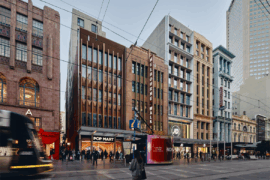
Merging two hotel identities in one landmark development, Hotel Indigo and Holiday Inn Little Collins capture the spirit of Melbourne through Buchan’s narrative-driven design – elevated by GROHE’s signature craftsmanship.
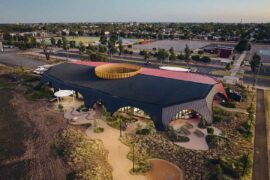
At the Munarra Centre for Regional Excellence on Yorta Yorta Country in Victoria, ARM Architecture and Milliken use PrintWorks™ technology to translate First Nations narratives into a layered, community-led floorscape.
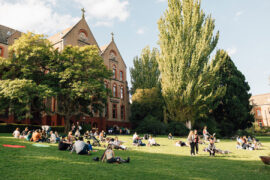
Abbotsford Convent has appointed Kennedy Nolan to guide the next stage of development at the heritage-listed Melbourne precinct, continuing its evolution as a cultural and community landmark.
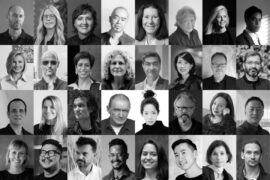
With the 2025 INDE.Awards now over, it’s time to take a breath before it all begins again in early December. However, integral to the awards this year and every year is the jury – and what an amazing group came together in 2025.
The internet never sleeps! Here's the stuff you might have missed

For a closer look behind the creative process, watch this video interview with Sebastian Nash, where he explores the making of King Living’s textile range – from fibre choices to design intent.
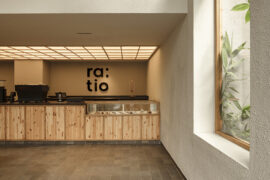
Ra:tio café blends calm interiors and lush outdoor spaces through VAL Atelier and The Pinewood Studio’s refined, contemporary design.